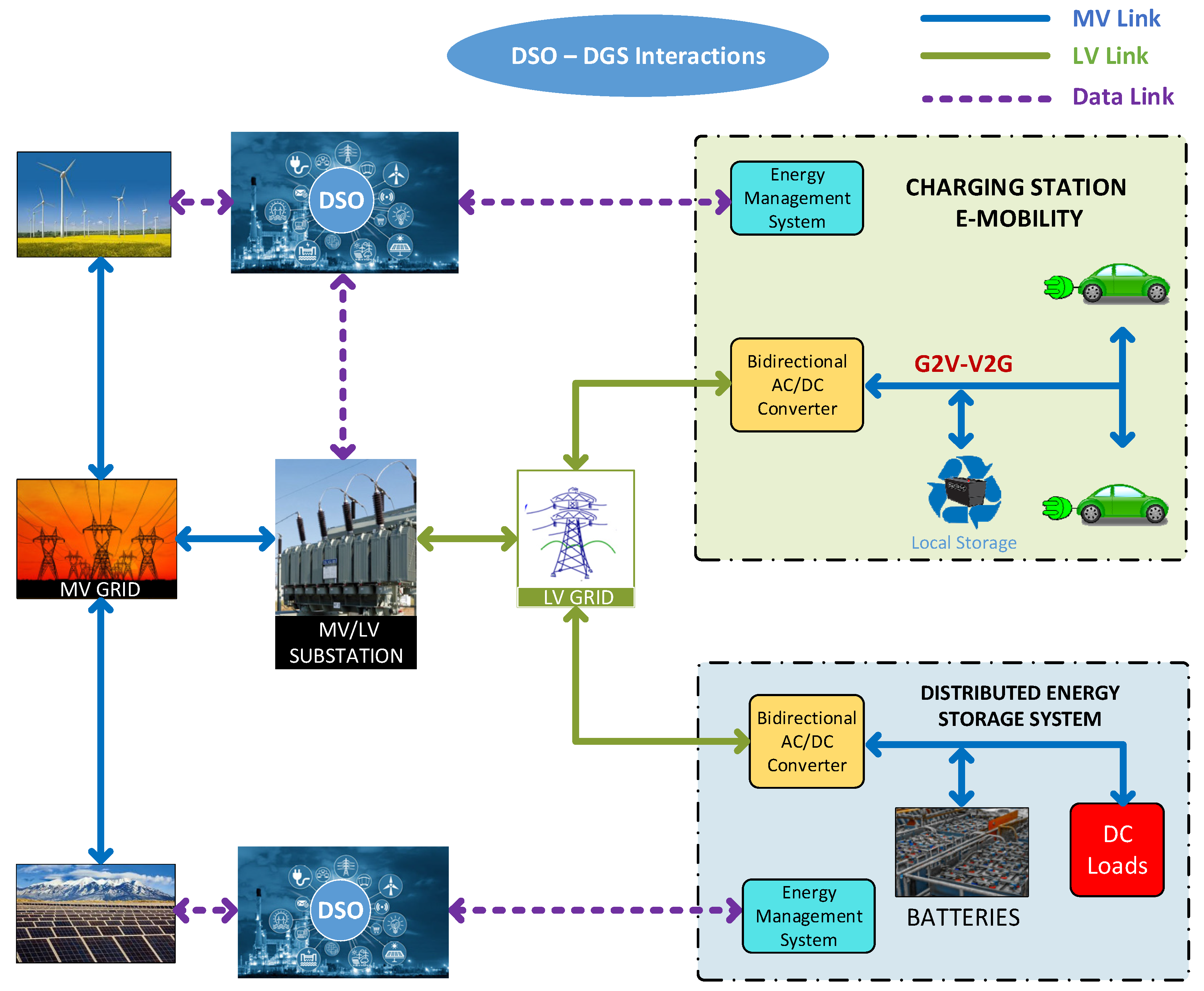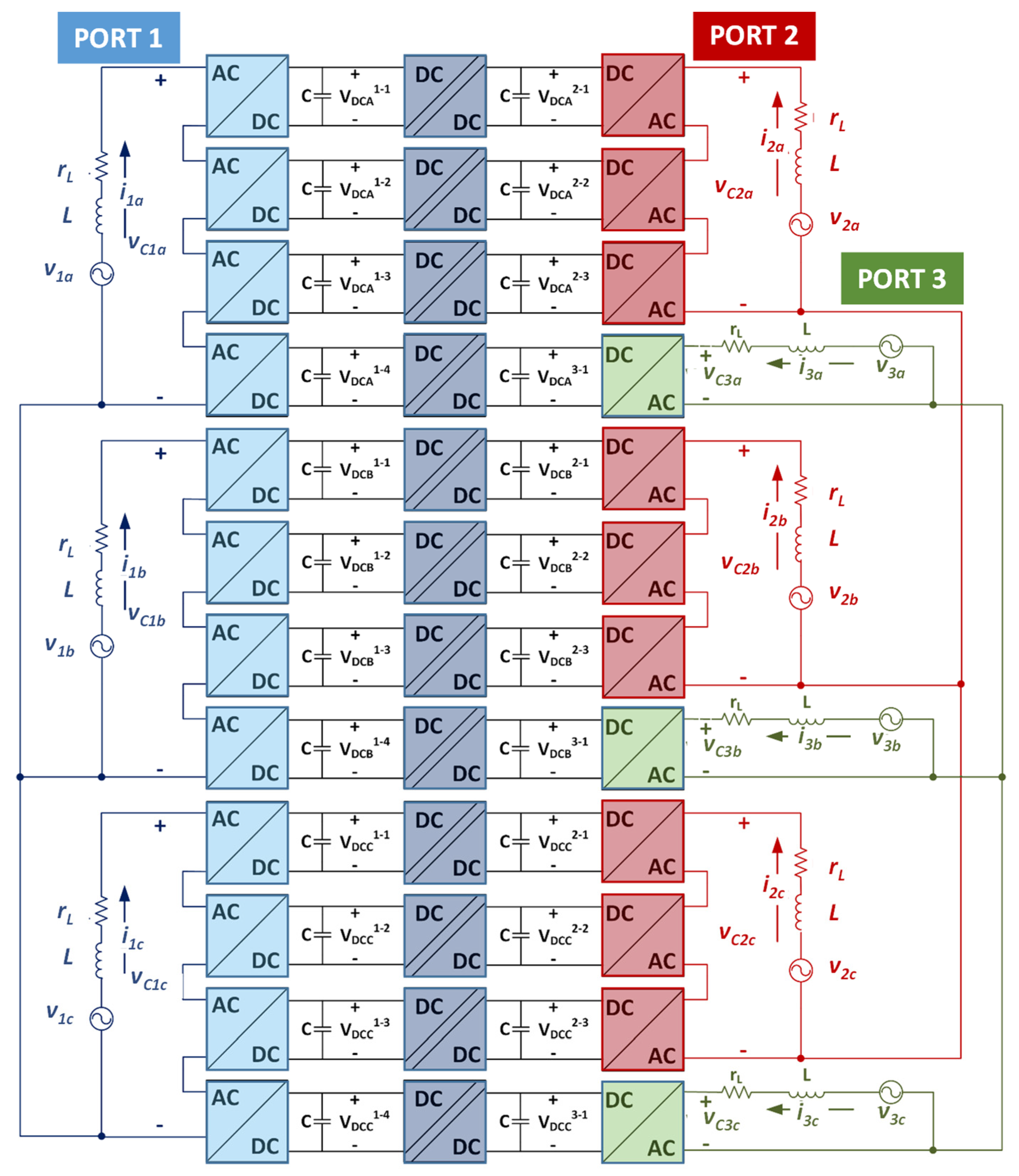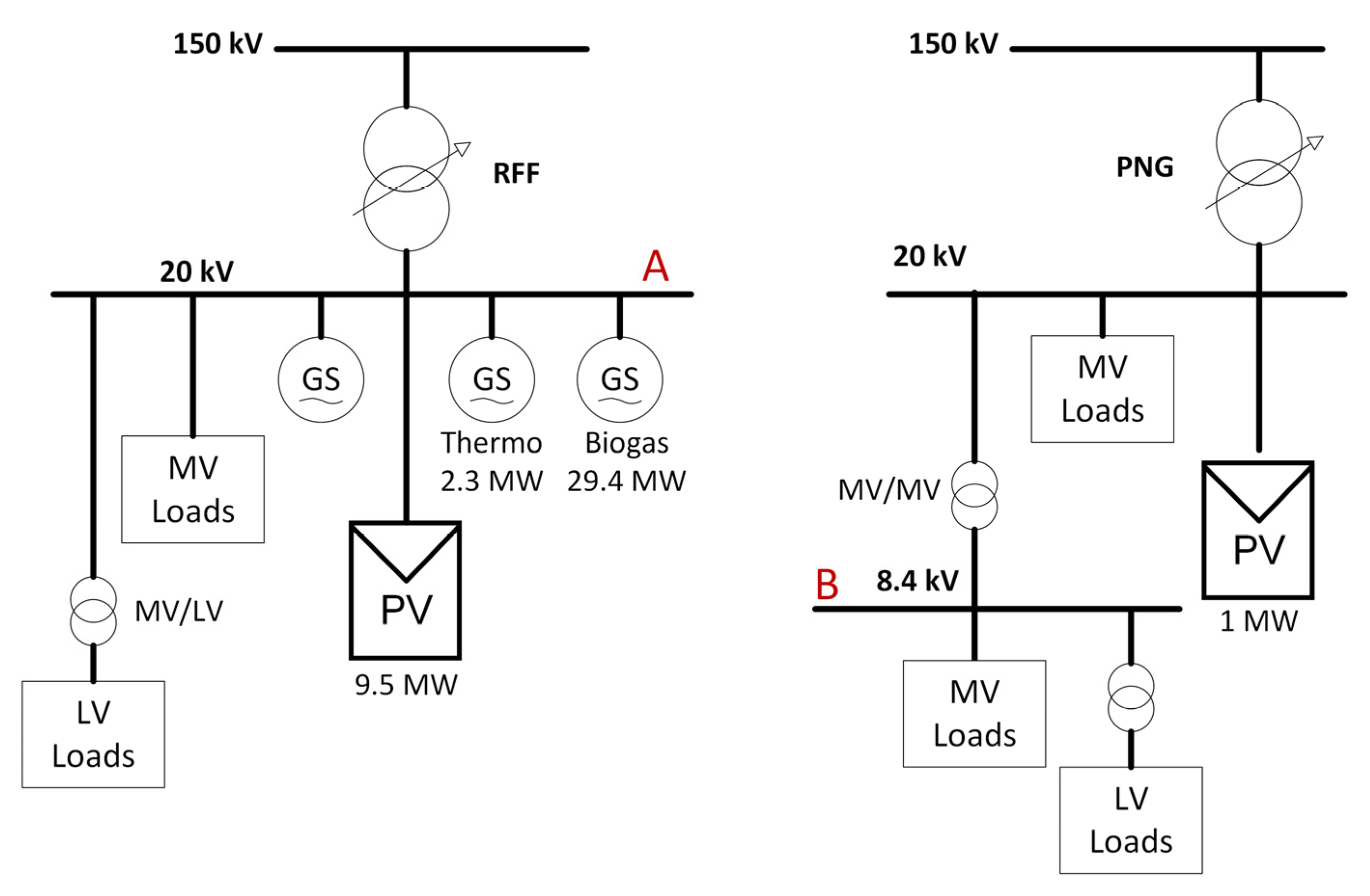Power Flow Management by Active Nodes: A Case Study in Real Operating Conditions
Abstract
:1. Introduction
2. UNIFLEX Converter
3. Network Clusters Description
4. Simulation Model
5. Discussion and Evaluation
5.1. Base Scenario
5.2. Scenario A
- The amount of energy EUNI, otherwise injected on the HV side through the RFF PS, is transferred through the UNIFLEX to the PNG line and sold to the users;
- Cost reduction due to the amount of energy EUNI no longer sink from the HV PNG line;
- Loss reduction due to the lower energy flow on the RFF and PNG HV/MV transformers.
5.3. Scenario B
6. Conclusions
Author Contributions
Funding
Data Availability Statement
Conflicts of Interest
References
- Yazdaninejadi, A.; Hamidi, A.; Golshannavaz, S.; Aminifar, F.; Teimourzadeh, S. Impact of inverter-based DERs integration on protection, control, operation, and planning of electrical distribution grids. Electron. J. 2019, 32, 43–56. [Google Scholar] [CrossRef]
- Delfanti, M.; Galliani, A.; Olivieri, V. The new role of DSOs: Ancillary Services from RES towards a local dispatch. In Proceedings of the Cired Workshop, Rome, Italy, 11–12 June 2014. [Google Scholar]
- Sbordone, D.A.; Carlini, E.M.; Di Pietra, B.; Devetsikiotis, M. The future interaction between virtual aggregator-TSO-DSO to increase DG penetration. In Proceedings of the International Conference on Smart Grid and Clean Energy Technologies (ICSGCE), Offenburg, Germany, 20–23 October 2015; pp. 201–205. [Google Scholar] [CrossRef]
- European Parliament. Directive (EU) 2019/944 of the European Parliament and of the Council of 5 June 2019 on Common Rules for the Internal Market for Electricity and Amending Directive 2012/27/EU. Available online: https://eur-lex.europa.eu/legal-content/EN/TXT/?uri=CELEX%3A32019L0944 (accessed on 22 July 2021).
- Vicente-Pastor, A.; Nieto-Martin, J.; Bunn, D.W.; Laur, A. Evaluation of flexibility markets for Retailer–DSO–TSO coordination. IEEE Trans. Power Syst. 2018, 34, 2003–2012. [Google Scholar] [CrossRef]
- Migliavacca, G.; Rossi, M.; Six, D.; Džamarija, M.; Horsmanheimo, S.; Madina, C.; Morales, J.M. SmartNet: H2020 project analysing TSO–DSO interaction to enable ancillary services provision from distribution networks. CIRED-Open Access Proc. J. 2017, 1, 1998–2002. [Google Scholar] [CrossRef] [Green Version]
- Madina, C.; Jimeno, J.; Ortolano, L.; Palleschi, M.; Ebrahimy, R.; Madsen, H.; Corchero, C. Technologies and Protocols: The Experience of the Three SmartNet Pilots. In TSO-DSO Interactions and Ancillary Services in Electricity Transmission and Distribution Networks; Springer: Berlin/Heidelberg, Germany, 2020; pp. 141–183. [Google Scholar]
- Xu, Y.; Zhang, J.; Wang, W.; Juneja, A.; Bhattacharya, S. Energy router: Architectures and functionalities toward Energy Internet. In Proceedings of the IEEE International Conference on Smart Grid Communications (SmartGridComm), Brussels, Belgium, 17–20 October 2011; pp. 31–36. [Google Scholar] [CrossRef]
- Huang, A.Q.; Crow, M.L.; Heydt, G.T.; Zheng, J.P.; Dale, S.J. The future renewable electric energy delivery and management (FREEDM) system: The energy internet. Proc. IEEE 2010, 99, 133–148. [Google Scholar] [CrossRef]
- Zhang, J.; Wang, W.; Bhattacharya, S. Architecture of solid state transformer-based energy router and models of energy traffic. In Proceedings of the IEEE PES Innovative Smart Grid Technol (ISGT), Washington, DC, USA, 16–20 January 2012; pp. 1–8. [Google Scholar] [CrossRef]
- Bhattacharya, S. MV Power Conversion Systems Enabled by High-Voltage SiC Devices. IEEE Power Electron. Mag. 2019, 6, 18–21. [Google Scholar] [CrossRef]
- She, X.; Huang, A. Solid state transformer in the future smart electrical system. In Proceedings of the IEEE Power & Energy Society General Meeting, Vancouver, BC, Canada, 21–25 July 2013; pp. 1–5. [Google Scholar] [CrossRef]
- Ruiz, F.; Perez, M.A.; Espinosa, J.R.; Gajowik, T.; Stynski, S.; Malinowski, M. Surveying Solid-State Transformer Structures and Controls: Providing Highly Efficient and Controllable Power Flow in Distribution Grids. IEEE Ind. Electron. Mag. 2020, 14, 56–70. [Google Scholar] [CrossRef]
- De Carne, G.; Buticchi, G.; Zou, Z.; Liserre, M. Reverse power flow control in a ST-fed distribution grid. IEEE Trans. Smart Grid 2017, 9, 3811–3819. [Google Scholar] [CrossRef]
- Das, D.; Hrishikesan, V.M.; Kumar, C.; Liserre, M. Smart Transformer-Enabled Meshed Hybrid Distribution Grid. IEEE Trans. Ind. Electron. 2021, 68, 282–292. [Google Scholar] [CrossRef]
- Costa, L.F.; Hoffmann, F.; Buticchi, G.; Liserre, M. Comparative Analysis of Multiple Active Bridge Converters Configurations in Modular Smart Transformer. IEEE Trans. Ind. Electron. 2019, 66, 191–202. [Google Scholar] [CrossRef] [Green Version]
- Zhao, B.; Zeng, R.; Song, Q.; Yu, Z.; Qu, L. Medium-Voltage DC Power Distribution Technology; The Energy Internet, Woodhead Publishing: Cambridge, UK, 2019; pp. 123–152. ISBN 9780081022078. [Google Scholar] [CrossRef]
- Alassi, A.; Ahmed, K.; Egea-Àlvarez, A.; Ellabban, O. Innovative Energy Management System for MVDC Networks with Black-Start Capabilities. Energies 2021, 14, 2100. [Google Scholar] [CrossRef]
- Zhao, B.; Song, Q.; Li, J.; Sun, Q.; Liu, W. Full-Process Operation, Control, and Experiments of Modular High-Frequency-Link DC Transformer Based on Dual Active Bridge for Flexible MVDC Distribution: A Practical Tutorial. IEEE Trans. Power Electron. 2017, 6751–6766. [Google Scholar] [CrossRef]
- Zhu, R.; Andresen, M.; Langwasser, M.; Liserre, M.; Lopes, J.P.; Moreira, C.; Rodrigues, J.; Couto, M. Smart transformer/large flexible transformer. CES Trans. Electron. Mach. Syst. 2020, 4, 264–274. [Google Scholar] [CrossRef]
- Alsokhiry, F.; Adam, G.P. Multi-Port DC-DC and DC-AC Converters for Large-Scale Integration of Renewable Power Generation. Sustainability 2020, 12, 8440. [Google Scholar] [CrossRef]
- Li, K.; Wen, W.; Zhao, Z.; Yuan, L.; Cai, W.; Mo, X.; Gao, C. Design and Implementation of Four-Port Megawatt-Level High-Frequency-Bus Based Power Electronic Transformer. IEEE Trans. Power Electron. 2021, 36, 6429–6442. [Google Scholar] [CrossRef]
- IEEE Recommended Practice for 1 kV to 35 kV Medium-Voltage DC Power Systems on Ships. In IEEE Std 1709–2018 (Revision of IEEE Std 1709–2010); IEEE: New York, NY, USA, 2018; pp. 1–54. [CrossRef]
- Giannakis, A.; Peftitsis, D. MVDC Distribution Grids and Potential Applications: Future Trends and Protection Challenges. In Proceedings of the 20th European Conference on Power Electronics and Applications (EPE’18 ECCE Europe), Riga, Latvia, 17–21 September 2018. [Google Scholar]
- New ERA for Electricity in Europe. Distributed Generation: Key Issues, Challenges and Proposed Solutions European Commission; EUR 20901; Office for Official Publications of the European Communities: Luxembourg, 2003; ISBN 92-894-6262-0.
- Akagi, H. Classification, terminology, and application of the modular multilevel cascade converter (MMCC). IEEE Trans. Power Electron. 2011, 26, 3119–3130. [Google Scholar] [CrossRef]
- Pipolo, S.; Bifaretti, S.; Lidozzi, A.; Solero, L.; Crescimbini, F.; Zanchetta, P. The ROMAtrix converter: Concept and operation. In Proceedings of the IEEE Southern Power Electronics Conference (SPEC), Puerto Varas, Chile, 4–7 December 2017; pp. 1–6. [Google Scholar] [CrossRef]
- Pipolo, S.; Zanchetta, P.; Bifaretti, S.; Lidozzi, A.; Solero, L.; Crescimbini, F. Power control capabilities of the ROMAtrix converter. In Proceedings of the IEEE Energy Conversion Congress and Exposition (ECCE), Portland, OR, USA, 23–27 September 2018; pp. 3955–3960. [Google Scholar] [CrossRef]
- Babokany, A.S.; Jabbari, M.; Shahgholian, G.; Mahdavian, M. A review of bidirectional dual active bridge converter. In Proceedings of the 9th International Conference on Electrical Engineering/Electronics, Computer, Telecom and Information Technology, Phetchaburi, Thailand, 16–18 May 2012; pp. 1–4. [Google Scholar] [CrossRef]
- Tarisciotti, L.; Zanchetta, P.; Pipolo, S.; Bifaretti, S. Three-port energy router for universal and flexible power management in future smart distribution grids. In Proceedings of the IEEE Energy Conversion Congress and Exposition (ECCE), Cincinnati, OH, USA, 1–5 October 2017; pp. 1276–1281. [Google Scholar] [CrossRef]
- La Mendola, M.; di Benedetto, M.; Lidozzi, A.; Solero, L.; Bifaretti, S. Four-Port Bidirectional Dual Active Bridge Converter for EVs Fast Charging. In Proceedings of the IEEE Energy Conversion Congress and Exposition (ECCE), Baltimore, MD, USA, 29 September–3 October 2019; pp. 1341–1347. [Google Scholar] [CrossRef]
- Iov, F.; Blaabjerg, F.; Clare, J.; Wheeler, P.; Rufer, A.; Hyde, A. UNIFLEX-PM–a key-enabling technology for future European electricity networks. EPE J. 2009, 19, 6–16. [Google Scholar] [CrossRef]
- Bifaretti, S.; Zanchetta, P.; Watson, A.; Tarisciotti, L.; Clare, J.C. Advanced power electronic conversion and control system for universal and flexible power management. IEEE Trans. Smart Grid 2011, 2, 231–243. [Google Scholar] [CrossRef]
- Peng, F.Z. Flexible AC transmission systems (FACTS) and resilient AC distribution systems (RACDS) in smart grid. Proc. IEEE 2017, 105, 2099–2115. [Google Scholar] [CrossRef]
- Kotsampopoulos, P.; Georgilakis, P.; Lagos, D.T.; Kleftakis, V.; Hatziargyriou, N. FACTS Providing Grid Services: Applications and Testing. Energies 2019, 12, 2554. [Google Scholar] [CrossRef] [Green Version]
- Ciobotaru, M.; Iov, F.; Bifaretti, S.; Zanchetta, P. Short-circuit analysis of the UNIFLEX-PM using stationary and natural reference frame control. EPE J. 2009, 19, 42–50. [Google Scholar] [CrossRef]
- Bifaretti, S.; Zanchetta, P.; Fan, Y.; Iov, F.; Clare, J. Power flow control through a multi-level H-bridge based power converter for universal and flexible power management in future electrical grids. In Proceedings of the 13th International Power Electronics and Motion Control Conference, Poznań, Poland, 1–3 September 2008; pp. 1771–1778. [Google Scholar] [CrossRef]
- Tarisciotti, L.; Watson, A.; Zanchetta, P.; Bifaretti, S.; Clare, J.; Wheeler, P. An improved dead-beat current control for cascaded H-bridge active rectifier with low switching frequency. In Proceedings of the 6th IET Int. Conf. on Power Electronics, Machines and Drives (PEMD), Bristol, UK, 27–29 March 2012. [Google Scholar] [CrossRef]
- Tarisciotti, L.; Zanchetta, P.; Watson, A.; Bifaretti, S.; Clare, J.C. Modulated model predictive control for a seven-level cascaded H-bridge back-to-back converter. IEEE Trans. Ind. Electron. 2014, 61, 5375–5383. [Google Scholar] [CrossRef]
- Tarisciotti, L.; Zanchetta, P.; Watson, A.; Wheeler, P.; Clare, J.C.; Bifaretti, S. Multiobjective modulated model predictive control for a multilevel solid-state transformer. IEEE Trans. Ind. Applic. 2015, 51, 4051–4060. [Google Scholar] [CrossRef]
- Dang, H.; Watson, A.; Clare, J.; Wheeler, P.; Kenzelmann, S.; de Novaes, Y.R.; Rufer, A. Advanced integration of multilevel converters into power system. In Proceedings of the 34th Annual Conference of IEEE Industrial Electronics, Orlando, FL, USA, 10–13 November 2008; pp. 3188–3194. [Google Scholar] [CrossRef]
- Pipolo, S.; Bifaretti, S.; Bonaiuto, V.; Tarisciotti, L.; Zanchetta, P. Reactive power control strategies for UNIFLEX-PM Converter. In Proceedings of the 42nd Annual Conference of the IEEE Industrial Electronics Society (IECON), Florence, Italy, 23–26 October 2016; pp. 3570–3575. [Google Scholar] [CrossRef]















| Name | Description | Value | Unit |
|---|---|---|---|
| C | DC-Link capacitor | 3100 | (μF) |
| rL | Inductor parasitic resistance | 0.5 | (Ω) |
| L | AC filter inductance | 11 | (mH) |
| P NOM | Rated power | 5 | (MVA) |
| V1 NOM | Rated peak value of the AC supply on port 1 (line-to-line) | 3300 | (V) |
| V2 NOM | Rated peak value of the AC supply on port 2 (line-to-line) | 3300 | (V) |
| V3 NOM | Rated peak value of the AC supply on port 3 (line-to-line) | 415 | (V) |
| VDC NOM | Rated capacitor voltage | 1100 | (V) |
| Generator Type | Rated Power (MW) | Line Name |
|---|---|---|
| Incinerator | 9 | REG |
| Biogas | 19.4 | ASC |
| Biogas | 10 | GIO |
| Thermoelectric | 2.3 | COT |
| Photovoltaic | 1 | PER |
| Photovoltaic | 8.5 | COT |
| Physical Links | RFF Substation 20 kV | PNG Substation 8.4 kV | Air Distance (km) | Ground Distance (km) | No. Active Nodes |
|---|---|---|---|---|---|
| 1 | RFF-A | PNG-A | 2.25 | 5.7 | 1 |
| 2 | RFF-B | PNG-B | 1.35 | 9.5 | 1 |
| 3 | RFF-C | PNG-C | 2.15 | 5.1 | 1 |
| 1 + 2 + 3 | all of the above | all of the above | 5.75 | 20.3 | 3 |
| TR 150–20 kV RFF | UNIFLEX-PM | |||
|---|---|---|---|---|
| Energy EHV (MWh) | Time Interval (h) | Energy EUNI (MWh) | Time Interval (h) | |
| Base Scenario | −3234 | 1836 | NA | NA |
| Scenario A | −1631 | 1173 | 1603 | 1836 |
| ITEM | Best Case (Overhead Cables) (k€) | Worst Case (Underground Cables) (k€) |
|---|---|---|
| UNIFLEX-PM | 200 | 260 |
| Power Lines | 60 | 570 |
| Secondary Substation | 10 | 16 |
| Electrical Devices | 15 | 20 |
| Total | 285 | 866 |
| TR 150–20 kV RFF | UNIFLEX-PM | |||
|---|---|---|---|---|
| Energy EHV (MWh) | Time Interval (h) | Energy EUNI (MWh) | Time Interval (h) | |
| Base Scenario | −3234 | 1836 | NA | NA |
| Scenario B | −254 | 280 | 2980 | 1836 |
| ITEM | Best Case (Overhead Cables) (k€) | Worst Case (Underground Cables) (k€) |
|---|---|---|
| UNIFLEX-PM | 600 | 780 |
| Power Lines | 152 | 1170 |
| Secondary Substation | 30 | 48 |
| Electrical Devices | 45 | 60 |
| Total | 827 | 2058 |
Publisher’s Note: MDPI stays neutral with regard to jurisdictional claims in published maps and institutional affiliations. |
© 2021 by the authors. Licensee MDPI, Basel, Switzerland. This article is an open access article distributed under the terms and conditions of the Creative Commons Attribution (CC BY) license (https://creativecommons.org/licenses/by/4.0/).
Share and Cite
Bifaretti, S.; Bonaiuto, V.; Pipolo, S.; Terlizzi, C.; Zanchetta, P.; Gallinelli, F.; Alessandroni, S. Power Flow Management by Active Nodes: A Case Study in Real Operating Conditions. Energies 2021, 14, 4519. https://doi.org/10.3390/en14154519
Bifaretti S, Bonaiuto V, Pipolo S, Terlizzi C, Zanchetta P, Gallinelli F, Alessandroni S. Power Flow Management by Active Nodes: A Case Study in Real Operating Conditions. Energies. 2021; 14(15):4519. https://doi.org/10.3390/en14154519
Chicago/Turabian StyleBifaretti, Stefano, Vincenzo Bonaiuto, Sabino Pipolo, Cristina Terlizzi, Pericle Zanchetta, Francesco Gallinelli, and Silvio Alessandroni. 2021. "Power Flow Management by Active Nodes: A Case Study in Real Operating Conditions" Energies 14, no. 15: 4519. https://doi.org/10.3390/en14154519
APA StyleBifaretti, S., Bonaiuto, V., Pipolo, S., Terlizzi, C., Zanchetta, P., Gallinelli, F., & Alessandroni, S. (2021). Power Flow Management by Active Nodes: A Case Study in Real Operating Conditions. Energies, 14(15), 4519. https://doi.org/10.3390/en14154519








